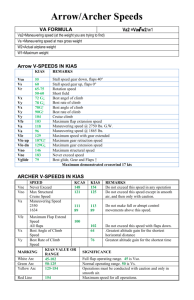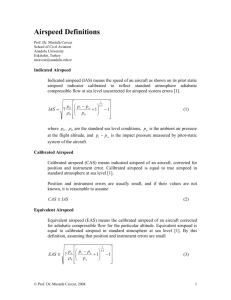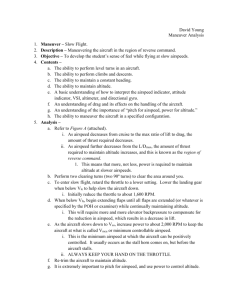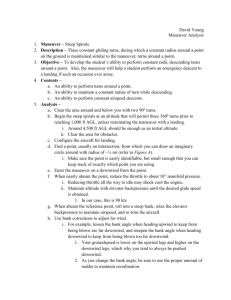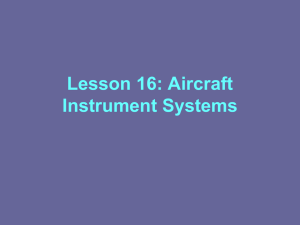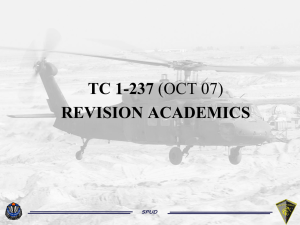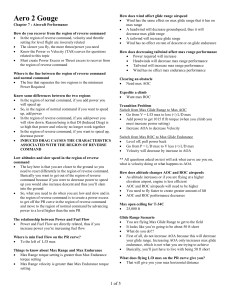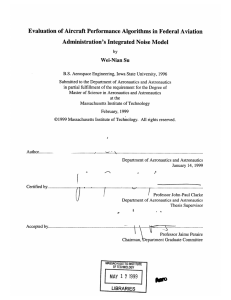Aero2Exam2
advertisement
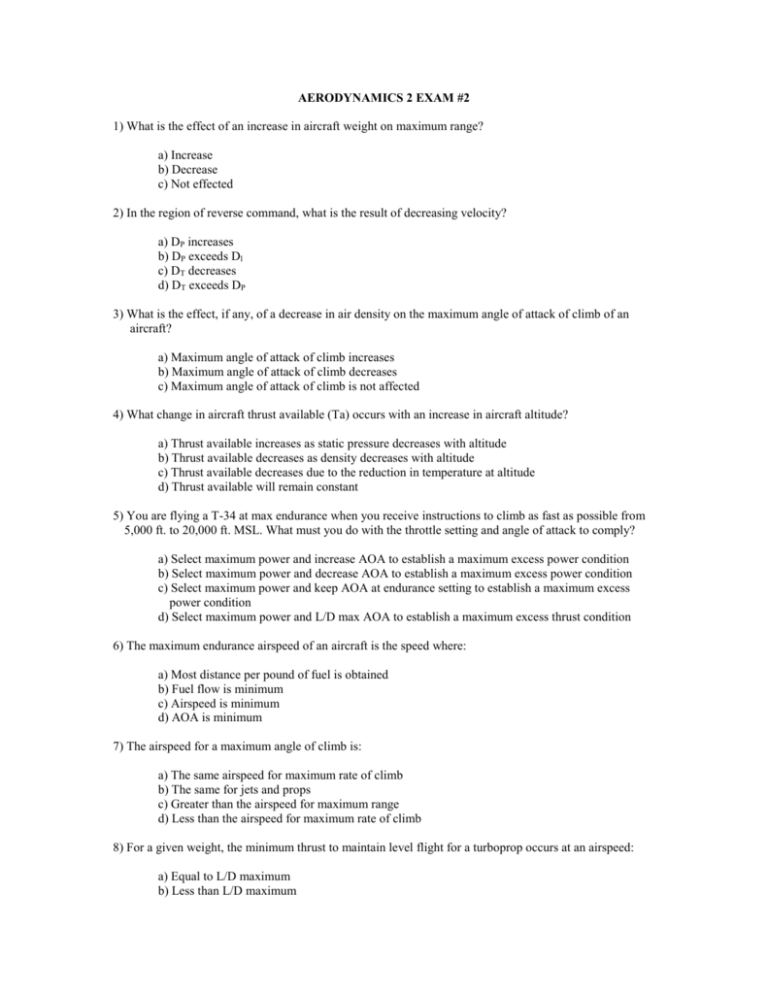
AERODYNAMICS 2 EXAM #2 1) What is the effect of an increase in aircraft weight on maximum range? a) Increase b) Decrease c) Not effected 2) In the region of reverse command, what is the result of decreasing velocity? a) DP increases b) DP exceeds Dl c) DT decreases d) DT exceeds DP 3) What is the effect, if any, of a decrease in air density on the maximum angle of attack of climb of an aircraft? a) Maximum angle of attack of climb increases b) Maximum angle of attack of climb decreases c) Maximum angle of attack of climb is not affected 4) What change in aircraft thrust available (Ta) occurs with an increase in aircraft altitude? a) Thrust available increases as static pressure decreases with altitude b) Thrust available decreases as density decreases with altitude c) Thrust available decreases due to the reduction in temperature at altitude d) Thrust available will remain constant 5) You are flying a T-34 at max endurance when you receive instructions to climb as fast as possible from 5,000 ft. to 20,000 ft. MSL. What must you do with the throttle setting and angle of attack to comply? a) Select maximum power and increase AOA to establish a maximum excess power condition b) Select maximum power and decrease AOA to establish a maximum excess power condition c) Select maximum power and keep AOA at endurance setting to establish a maximum excess power condition d) Select maximum power and L/D max AOA to establish a maximum excess thrust condition 6) The maximum endurance airspeed of an aircraft is the speed where: a) Most distance per pound of fuel is obtained b) Fuel flow is minimum c) Airspeed is minimum d) AOA is minimum 7) The airspeed for a maximum angle of climb is: a) The same airspeed for maximum rate of climb b) The same for jets and props c) Greater than the airspeed for maximum range d) Less than the airspeed for maximum rate of climb 8) For a given weight, the minimum thrust to maintain level flight for a turboprop occurs at an airspeed: a) Equal to L/D maximum b) Less than L/D maximum c) Equal to CL maximum d) Where CD is zero 9) While flying maximum endurance in a T-34 at 10,000 feet, you receive a radio transmission telling you to climb to 15,000 feet ASAP. What should you do to AOA and power to achieve this? a) Decrease AOA, increase power b) Decrease AOA, decrease power c) Increase AOA, increase power d) Maintain AOA, increase power 10) If you have thrust, you have power (thrust horsepower). a) True b) False 11) Another T-34c wants to race you to 10,000 feet from takeoff. What climb profile should you use? a) From the thrust curve, use L/D max AOA and airspeed b) From the power curve, use L/D max AOA and airspeed c) Fly max power excess at L/D max d) Both b and c 12) The ailerons control: a) Pitch b) Roll c) Yaw 13) For trimming, trim tabs are _____ moved in the opposite direction as the control surface. a) Sometimes b) Never c) Always 14) The T-34 rudder and elevator trim will be adjusted: a) Only once after takeoff b) Frequently during flight because they are sensitive to power and airspeed changes c) Never 15) Power changes take precedence at low speed. a) True b) False 16) Which form of balancing is used to balance the forces that act at the aerodynamic center? a) Mass balance b) Aerodynamic balance c) Control-free balance 17) Mass balance requires that weights be placed inside control surfaces of the T-34 in the areas forward of the hingeline to locate the CG on the hingeline. a) True b) False 18) A servo trim tab is found on the T-34’s: a) Aileron b) Rudder c) Elevator 19) The position with respect to time or motion of an object after disturbance is called: a) Dynamic stability b) Static stability c) Divergent oscillation 20) To increase an airplane’s maneuverability you could: a) Strengthen stability and use larger control surfaces b) Weaken stability and use larger control surfaces c) Weaken stability and use smaller control surfaces 21) The neutral point defines the farthest aft CG position without negative stability. a) True b) False 22) Which of the following has a negative effect on directional stability? a) Straight wings b) Swept wings c) Fuselage d) Vertical stabilizer 23) Swept wings are laterally stabilizing. a) True b) False 24) Phugoid oscillations are long period oscillations (20-100 seconds) of altitude and airspeed while maintaining a nearly constant angle of attack. a) True b) False 25) The T-34c is not subject to pilot induced oscillations since it does not have strong longitudinal static stability. a) True b) False 26) In a spin, if you apply opposite rudder but hold full back stick you will: a) Enter a progressive spin b) Enter a flat spin c) Enter an inverted spin d) Buy the farm 27) What factors make up a spin? a) An incomplete stall, roll and drag b) A complete stall, yaw and roll c) A rolling moment 28) The higher the pitch attitude, the _____ the vertical component of thrust, and the _____ the stall speed. a) Greater, higher b) Greater, lower c) Lesser, higher d) Lesser, lower 29) In a stall, the greater lift on the up-going wing results in: a) A continued rolling motion of the airplane b) A continued yawing motion of the airplane c) Discontinuing the rolling motion of the airplane d) Discontinuing the yawing motion of the airplane 30) The turn needle is the only reliable indicator of spin direction. a) True b) False 31) In an inverted spin, what type of G’s are experienced? a) Positive b) Negative c) Transverse 32) The spin recovery technique in the T-34 is forward stick and opposite rudder. a) True b) False 33) What is the maximum aircraft limit load factor? a) The maximum load factor that can be sustained without over-stressing the aircraft b) The load factor at which structural failure occurs c) The airspeed at which structural failure occurs d) The maximum amount of weapons the wing can hold 34) What flight regime will produce sufficient aerodynamic force to cause the airplane structure to flex, resulting in wing flutter, aileron reversal, or wing divergence? a) Flight at red-line airspeed b) Flight at a velocity greater than red-line airspeed c) Flight at a velocity greater than maneuver airspeed d) Flight at a velocity greater than Vmin 35) If you increase airspeed, your red-line airspeed will: a) Increase b) Decrease c) Remain constant 36) What values are plotted on the to axes of the Vg/Vn diagram? a) TAS and G’s b) IAS and weight c) G’s and “n” factor d) Load factor and IAS 37) Which of the following should you increase to decrease the size of the V-n diagram? a) Altitude b) Weight c) Asymmetrical wing loading d) All of the above 38) Exceeding limit load at maneuver airspeed will always cause structural damage. a) True b) False 39) Positive accelerated stalls: a) Never occur above maneuver speed b) At a constant airspeed will always occur before over-stress c) Are always above the positive load limit d) None of the above 40) Turbulent penetration airspeed is 2/3 of maneuver airspeed. a) True b) False 41) In a standard rate turn, you will turn 360 o in: a) 60 seconds b) 90 seconds c) 120 seconds d) 180 seconds 42) What is the structural deformation which occurs as a function of time because the part is subjected to constant stress that causes plastic strain? a) Yield stress b) Ultimate stress c) Aerodynamic stress d) Creep damage 43) What will cause both limit load factor and ultimate load to decrease? a) An increase in altitude b) A decrease in altitude c) An increase in gross weight d) A decrease in gross weight 44) Which of the following factors has the greatest affect on takeoff distance? a) Velocity b) Weight c) Rolling friction d) Density 45) What is the safest way to stop after touchdown? a) Aerodynamic braking b) Friction braking c) Crash into a wall d) Both a and b 46) Two identical aircraft prepare for takeoff. The first aircraft will be departing from NAS Oceana, VA (sea level). The other from Colorado Springs (6930 feet). Which aircraft will have a longer takeoff roll and why? a) Colorado Springs: lower air density causes an increase in takeoff TAS b) NAS Oceana: higher air density causes an increase in takeoff TAS c) Colorado Springs: lower air density causes an increase in takeoff IAS d) NAS Oceana: lower air density causes an increase in takeoff IAS 47) When is rolling friction greatest during takeoff? a) At the beginning b) At the half way point c) At the 2/3 point d) At the point of liftoff 48) What runway wind component reduces the aircraft takeoff distance requirement? a) Headwind b) Tailwind c) Crosswind d) Calm wind conditions 49) What is the coefficient of braking friction dependent upon? a) Runway surface condition, weight, headwind b) Runway length, thrust, tailwind c) Runway surface condition, tire type, temperature d) Runway surface condition, tire type, degree of brake application 50) What change in power setting is required in the final phase of the field approach to maintain the desired flight path as the airplane nears the ground? a) Increase b) Decrease c) No change KEY 1) b 2) d 3) b 4) b 5) b 6) b 7) d 8) a 9) a 10) b 11) d 12) b 13) c 14) b 15) a 16) b 17) a 18) a 19) a 20) b 21) a 22) c 23) a 24) a 25) a 26) a 27) b 28) b 29) a 30) a 31) b 32) a 33) a 34) b 35) b 36) d 37) d 38) b 39) d 40) b 41) c 42) d 43) c 44) b 45) d 46) a 47) a 48) a 49) d 50) b

